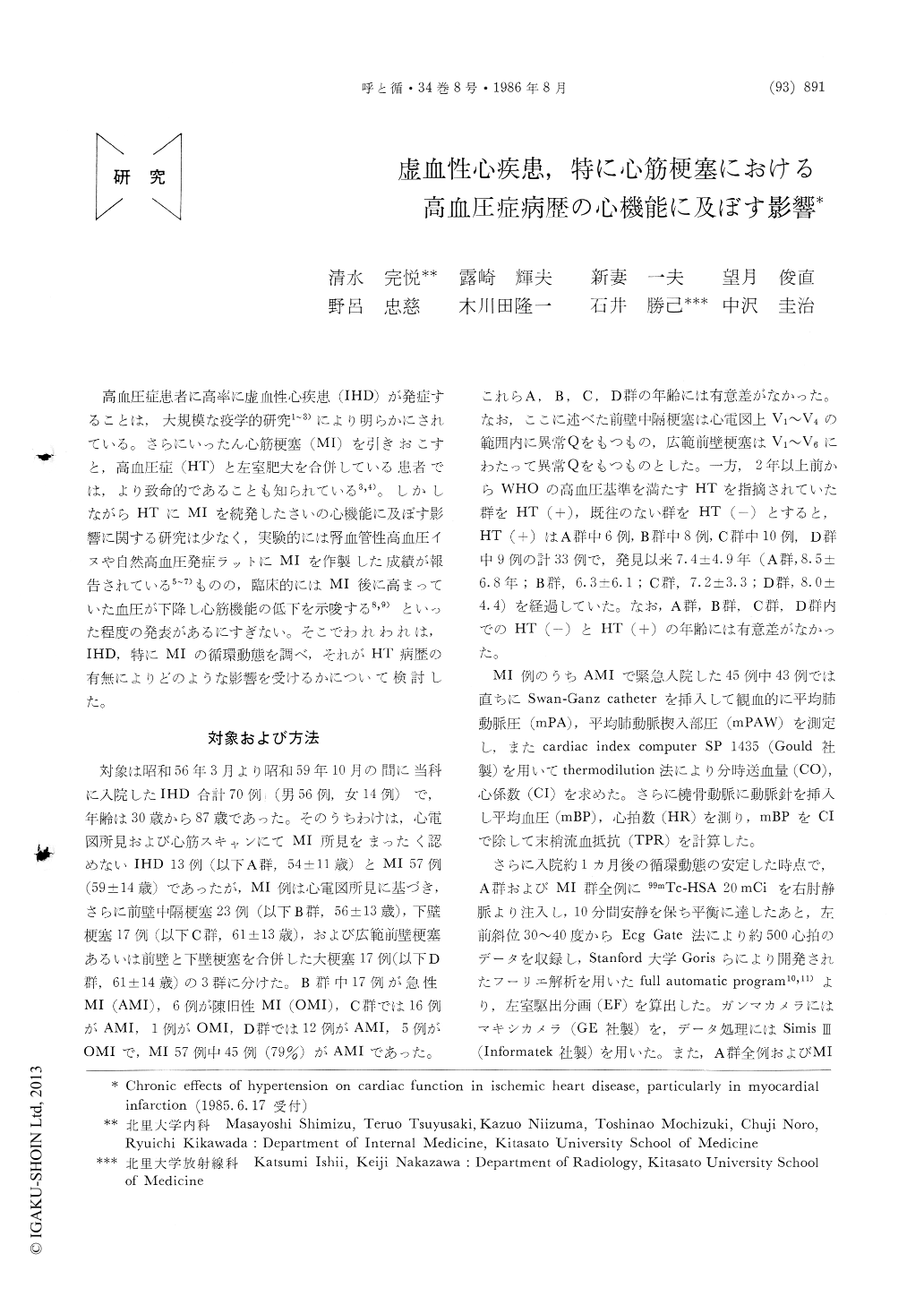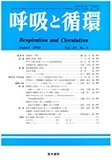Japanese
English
- 有料閲覧
- Abstract 文献概要
- 1ページ目 Look Inside
高血圧症患者に高率に虚血性心疾患(IHD)が発症することは,大規模な疫学的研究1〜3)により明らかにされている。さらにいったん心筋梗塞(MI)を引きおこすと,高血圧症(HT)と左室肥大を合併している患者では,より致命的であることも知られている3,4)。しかしながらHTにMIを続発したさいの心機能に及ぼす影響に関する研究は少なく,実験的には腎血管性高血圧イヌや自然高血圧発症ラットにMIを作製した成績が報告されている5〜7)ものの,臨床的にはMI後に高まっていた血圧が下降し心筋機能の低下を示唆する8,9)といった程度の発表があるにすぎない。そこでわれわれは,IHD,特にMIの循環動態を調べ,それがHT病歴の有無によりどのような影響を受けるかについて検討した。
There are few reports concerning chronic effects of hypertension (HT) on cardiac function in ischemic heart disease (IHD). Therefore, this study was aimed to clarify the influence of longstanding HT on systemic hemodynamics in patients with IHD, particularly in those with myocardial infarction (MI).
Thirteen patients with IHD who didn't have any sign of MI (group A), and 57 patients with MI were studied. Patients with MI were divided into the follow-ing 3 groups according to the findings of electrocardio-gram. Group B: 23 patients with anteroseptal MI. Group C : 17 patients with inferior MI. Group D : 17 patients with large MI (extensive anterior, or anterior+ inferior). Of these 70 patients, 33 had past history of HT (PHT) with the duration of 7.4 yrs±4.9 (M± SD). In 43 patients with acute MI (AMI), hemodyna-mics were examined through Swan-Ganz catheter soon after their admission. Approximately one month later after admission, RI ejection fraction (EF) by multi-gate method, cardiac output (CO) by ear-piece dye dilution method, and systolic time intervals were deter-mined. Using CO and cuff blood pressure, total peri-pheral resistance (TPR) was calculated.
In patients with AMI, no manifest differences in hemodynamics were seen soon after admission between the subgroup with PHT and that without PHT in group B, group C, or group D. One month after admission, EF and ET/PEP were similar between the subgroup with PHT and that without PHT in group A, group B, or group C. However, in group D, the subgroup with PHT showed more markedly decreased EF and ET/PEP than that without PHT (EF, 15.8±7.3% vs 35.3±15.9. p<O.01 : ET/PEP, 2.23±0.47 vs 2.94±0.45, p<0.01). As EF is affected by afterload, the relation of EF and TPR was further examined. An inverse linear correlation (y=57.2-0.40x, r=-0.52, p<0.01) was obtained in group B and group C. Group A was situated in similar or higher places than that regression line. On the contrary, group D was situated in lower places, particularly in the subgroup with PHT. Therefore, patients with PHT in group D were found to have the remarkably reduced left ventricular cont-ractility.
There are several possibilities why mortality rate is high in IHD with PHT. 1) advanced coronary sclerosis and large ischemic region. 2) reduced coronary reserve. 3) already impaired cardiac function before cardiac accidents. According to our results, significant differen-ces in cardiac function were observed in group D bet-ween the subgroup with PHT and that without PHT I month after admission. At this stage, fibrotic healing process is undergoing or finished. Therefore, the abnor-mal diastolic performance may also make some contribu-tion towards these aggravations of the systolic cardiac performance. Lastly, to examine the relation of EF and TPR is supposed to be clinically valuable to judge the cardiac contractility because EF is greatly influenced by afterload.

Copyright © 1986, Igaku-Shoin Ltd. All rights reserved.


